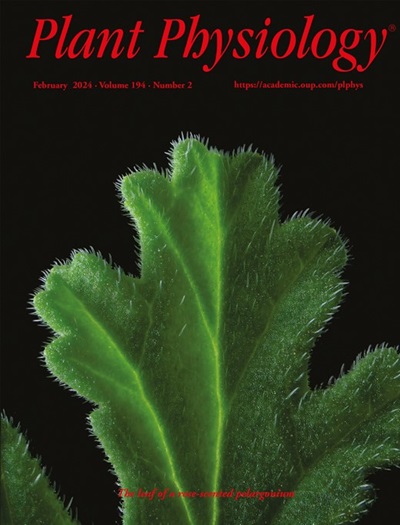C4 plants respond to phosphate starvation differently than C3 plants.
IF 6.9
1区 生物学
Q1 PLANT SCIENCES
引用次数: 0
Abstract
C4 photosynthesis concentrates CO2 around RUBISCO, thereby decreasing photorespiration and leading to greater productivity. C4 photosynthesis evolved several times independently in different plant families including monocots and dicots. Beside changes in carbon fixation, C4 plants have also evolved several alterations in nitrogen and sulfur nutrition, leading to a better nitrogen use efficiency. Here, we utilized C3 and C4 species from two model systems, Flaveria and Panicum, to ask whether the evolution of C4 photosynthesis also affected phosphate homeostasis. The accumulation of phosphate within the plant shifted from the roots to the shoots with the evolution of C4, which can probably be explained by the higher demand of phosphate for completing the C4 cycle. A limitation of carbon assimilation by phosphate availability was shown solely for the C4 dicot plant, indicating a higher sensitivity to the starvation. Metabolic responses to phosphate limitation, including accumulation of amino acids, TCA cycle intermediates, as well as starch, were genus or species specific, rather than associated with the photosynthesis type. The expression of key phosphate starvation response genes was induced in all species by phosphate deficiency, while the high induction of microRNA399 coupled with a repression of PHOSPHATE 2 (PHO2) was especially prominent in the C4 monocot. Thus, it seems that C4 photosynthesis increases the demand for phosphate in the leaves and C4 plants either respond more strongly to phosphate deficiency than C3 plants or experience inhibition of photosynthesis.C4植物对磷酸盐饥饿的反应与C3植物不同。
C4光合作用将二氧化碳集中在RUBISCO周围,从而减少光呼吸并导致更高的生产力。C4光合作用在包括单子叶植物和双子叶植物在内的不同植物科中独立进化了几次。除了碳固定的变化,C4植物在氮和硫营养方面也发生了一些变化,从而提高了氮的利用效率。本研究利用黄草属(Flaveria)和梧桐属(Panicum)两个模式系统中的C3和C4物种,探讨C4光合作用的进化是否也影响了磷酸盐的稳态。随着C4的进化,植株内磷酸盐的积累从根向茎转移,这可能与完成C4循环对磷酸盐的需求更高有关。磷酸盐有效性对碳同化的限制仅表现在C4双科植物上,表明其对饥饿的敏感性更高。对磷酸盐限制的代谢反应,包括氨基酸、TCA循环中间体和淀粉的积累,是属或种特有的,而不是与光合作用类型有关。磷酸盐缺乏诱导了所有物种的关键磷酸饥饿反应基因的表达,而microRNA399的高诱导和磷酸2 (PHO2)的抑制在C4单子叶中尤为突出。因此,C4光合作用增加了叶片对磷酸盐的需求,C4植物对磷酸盐缺乏的反应比C3植物更强烈,或者光合作用受到抑制。
本文章由计算机程序翻译,如有差异,请以英文原文为准。
求助全文
约1分钟内获得全文
求助全文
来源期刊

Plant Physiology
生物-植物科学
CiteScore
12.20
自引率
5.40%
发文量
535
审稿时长
2.3 months
期刊介绍:
Plant Physiology® is a distinguished and highly respected journal with a rich history dating back to its establishment in 1926. It stands as a leading international publication in the field of plant biology, covering a comprehensive range of topics from the molecular and structural aspects of plant life to systems biology and ecophysiology. Recognized as the most highly cited journal in plant sciences, Plant Physiology® is a testament to its commitment to excellence and the dissemination of groundbreaking research.
As the official publication of the American Society of Plant Biologists, Plant Physiology® upholds rigorous peer-review standards, ensuring that the scientific community receives the highest quality research. The journal releases 12 issues annually, providing a steady stream of new findings and insights to its readership.
 求助内容:
求助内容: 应助结果提醒方式:
应助结果提醒方式:


